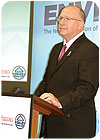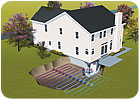
But tell them that this same energy source equates to: taking nearly 1,295,000 cars off the road; planting more than 385 million trees; and reducing reliance on imported fuels by 21.5 million barrels of crude oil per year, and they may sit up and take notice.
That energy source is ground-source geothermal. Often referred to as "free energy from the earth," geothermal comes from the Greek words geo, meaning earth, and therme, meaning heat. Geothermal literally means "earth heat." Its popularity has grown as homeowners and business owners seek means for achieving higher efficiency in their HVAC systems while reducing energy costs. Also, an important byproduct of higher efficiency and lower costs is an environmentally friendly system that helps preserve the Earth's eco-structure, i.e., a green solution.
"In this age of rising energy costs, high efficiency is extremely important to our future," said Jeff Hammond, director of marketing for ClimateMaster Inc. "Geothermal systems are the highest efficiency means of heating and cooling on the market today. The high efficiency comes from proven heat pump technology, but with a milder heat source/heat sink, the Earth. Geothermal technology is typically twice as efficient in annual operating costs as comparable air-source technology.
"Geothermal may grow as much as 800 percent by 2010," said Wael El-Sharif, executive director of the Geothermal Heat Pump Consortium (GHPC). That comes as good news for a country that is still dependent on foreign oil imports and the vulnerability of the Middle East oil market in times of terrorism and threats to national security. "There is nothing more secure than using our own renewable energy source and nothing more American than using our own energy resources," El-Sharif said.
He made his comments at a recent press conference hosted by WaterFurnace International to announce its newest furnace, the Envision. At the same press conference, Phillip Shaull, regional director for the Northeast Indiana Office of U.S. Senator Richard Lugar, said, "Energy is the albatross of U.S. national security."
Thomas Spall, owner of T.E. Spall & Son Inc., Carbondale, Pa., said his company is designing a geothermal system with radiant flooring for an upscale animal boarding hotel in New York. He is convinced that geothermal will one day make up half of his business.
"I have between $500,000-$600,000 in geothermal in the works or on the books for 2006," he said. "Geothermal work is up over 300 percent this year and revenues are up even more than that."
CONTINUING THE POSITIVES
"Today's commercial environment, including schools, rely on the most energy efficient methods to maintain low operating cost, meet IAQ requirements, and provide a comfortable indoor work or learning environment," said Dick Hanna, director of product development for Bard Manufacturing. "Geothermal units have the ability to harness the Earth's energy in the soil that result in higher operating efficiency and lower operating cost than other heating and cooling options."At his Envision press conference, Bruce Ritchey, CEO of WaterFurnace International, gave some statistics about the cost savings of geothermal.
"These are annual heating, cooling, and hot-water costs for a typical 2,500-square-foot home," he said. "Geothermal: $780; high efficiency natural gas and a/c: $1,497; air-source heat pump: $1,608; and high-efficiency propane and a/c: $2,305."
Since consumers want a system that offers paybacks and represents a sizable investment, convincing arguments can be made for installing a geothermal HVAC system. System payback is how long it takes to recover, in energy savings, the difference in the costs between geothermal and other systems. On average, according to WaterFurnace, the added initial cost of installing a geothermal system can be recovered within three to five years.

"Most consumers ignore the fact that the heating and cooling system is only a small investment when compared to the cost of a complete structure," said Hanna. "This is an investment that is spread out over a long period of time. While the additional cost of loops or wells for the geothermal system seem objectionable over other system choices, that additional cost will also be spread out over the life of the facility."
Hanna noted that the additional paybacks of geothermal come in the day-to-day operating cost. "Based on comparison to an air-to-air heat pump, that annual heating and cooling cost could be 40-50 percent less," he said. "In real numbers an air-to-air system with an annual operating cost of $1,200 per year would relate into a geothermal annual operating cost of $600-$700."
Ritchey, whose Envision furnace has the distinction of having the highest heating and cooling efficiency of any product certified by Air-Conditioning & Refrigeration Institute (ARI) in the ground loop heat pumps category - 30 EER (see sidebar story) - used his product as an example of the efficiency of geothermal. "This product is the equivalent of introducing a car that rides like a Cadillac, but gets 75 miles to the gallon," he said. "The unit is twice as efficient as the highest efficiency conventional air conditioners and five times more efficient than the highest efficiency gas furnaces."
Hammond said that if consumers compared apples to apples, geothermal equipment "actually costs less."
"Compare the highest efficiency air-source or fossil fuel technologies, not builder model efficiencies," he said. "The additional cost is in the ground loop, which typically has a payback of 3-7 years. However, when financed in a new home loan, the system starts paying back immediately. Plus, the life expectancy is longer than traditional systems and maintenance is lower."
Spall said that he could show his customers significant paybacks on a geothermal system. "Paybacks are coming down and objections to the initial costs are coming down, too," he said. Spall commented that the owner of the animal boarding hotel he designed the system for chose geothermal after researching the system, finding that geothermal is also environmentally a wise choice.
Rick Wolf, home improvement expert and radio talk show host from the Ft. Wayne area, also spoke at the Envision press conference and noted that geothermal is not only for the new construction market. He said the timing is ripe for the replacement market. "The 70s were the most prolific home building time in history and homes are still full of 80 percent efficient furnaces," he said. Wolf said that 61.8 percent of single detached homes in the United States have been built before 1980.
One more advantage of the popularity of geothermal technology is evidenced by its impact on the Ft. Wayne economy. At the press conference Ft. Wayne mayor Graham Richard said, "Energy innovation is about obtaining and retaining jobs in our country."
For more information, visit www.waterfurnace.com, www.bardhvac.com, and www.climatemaster.com.
SIDEBAR: RINGING UP SALES
Almost 20 years ago Collier's Heating & Air Conditioning of northern Indiana began "digging into" the geothermal market. The company sold 20 geothermal systems that year. As the years went by, the numbers went up, until 2000 when the contractor became the largest geothermal dealer in Indiana. But it didn't stop there."We sold 100 jobs in 2005 and expect to sell almost 180 jobs in 2006," said Collier's co-owner Todd Zeplin. Zeplin, along with co-owners Joe Collier and Ken Diekhoff, as well as their 42 employees, see an unlimited future in selling and installing geothermal systems. These systems currently represent 75 percent of Collier's business.
Due to a slew of information about geothermal which has been made available to consumers in areas served by Colliers - Ossian and Warsaw - the demand for geothermal energy has steadily increased over the past decade. And the recent spike in energy costs have people looking for alternative energy sources to heat and cool their homes.
But perhaps the biggest reason why Collier's and other geothermal dealers have fared well with educated consumers is the fact that WaterFurnace International, manufacturer of geothermal equipment, is located literally in their backyard: Fort Wayne.
"A couple of years ago we co-sponsored an open house at the WaterFurnace factory and drew in 300 people," said Zeplin. "The event was co-sponsored by Collier's, our distributor, and the local utility. Home improvement personality Rick Wolf had a call-in talk show from the open house. Colliers had their own room to talk with customers and give some estimates on what it would cost to switch to geothermal."
The contractor continues to co-sponsor educational seminars for consumers and Zeplin estimates that hundreds of consumers have attended them.
Zeplin is proud of the fact that Collier's has captured this niche market but he is also happy to still have a number of customers who use other energy sources - and it's not because he necessarily wants to diversify.
"I don't want to give up my gas furnace business because I would lose the opportunity to convert them over to geothermal at some point," he said. "If I went 100 percent geothermal I'd lose a lot of opportunity for my salespeople to convert from propane and natural gas to geothermal."
But his installers probably wouldn't mind going 100 percent geothermal. "All of my guys would rather install geothermal than a gas furnace and air conditioner. It is easier, it is all inside, and it takes the same amount of time to install each."
It isn't just new installations that Zeplin is talking about. "The retrofit market is really picking up," he said.
SIDEBAR: EER VERSUS SEER
Energy efficiency ratio (EER) is a measure of how efficiently a cooling system will operate when the outdoor temperature is at a specific level (usually 95°F). A higher EER means the system is more efficient. The term EER is most commonly used when referring to window and unitary air conditioners and heat pumps, as well as water-source and geothermal heat pumps.Seasonal energy efficiency ratio (SEER) measures how efficiently a residential central cooling system (air conditioner or heat pump) will operate over an entire cooling season, as opposed to a single outdoor temperature. As with EER, a higher SEER reflects a more efficient cooling system. SEER is calculated based on the total amount of cooling (in Btu) the system will provide over the entire season divided by the total number of watt-hours it will consume. By federal law, every central split cooling system manufactured in the United States today must be at least 13 SEER.
Publication date: 11/13/2006

Report Abusive Comment